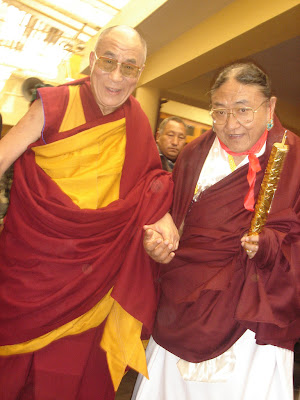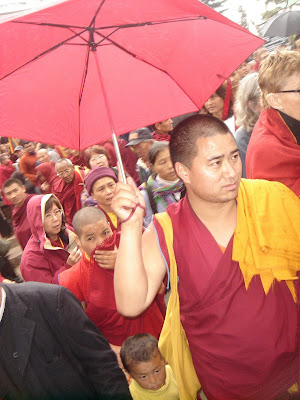Dharamsala, Himachal Pradesh
The Extra Special Super Auspicious Healthy
 Good-Luck Long Life pujas are finally over. I think I have a Triple H (His Holiness Hangover).
Good-Luck Long Life pujas are finally over. I think I have a Triple H (His Holiness Hangover).HH the Dalai Lama just left for a gig in Pune on the 23rd, and the town has resumed its rather pensive "waiting" vibe. The weather warms daily in preparation for "high tourist season."
Wild Kingdom
I have spent the last few days doing blessedly little, mainly taking wonderful walks out by the Bhagsunath waterfall, reading two Tibet-related books (Kundun by Mary Craig and Dance of 17 Lives by Mick Brown).
And, listening to the wild birds call.
The white butterflies have hatched. My friend Victoria says that every year after Spring Teachings, they come out in their hundreds, filling the air in living snow flurries. You see them in twos, usually. Tiny pure-white butteflies.
The mongoose (mongeese? mongooses?) are having a high old time - it must be mating season. They are slinking round the hillsides, their tails far longer than their bodies. Raju says they live in a den just outside the guest house.
I can always tell it's Sunday, by the hordes of Indian family tourists traipsing / driving in streams of mini-cabs and SUVS like a parade, honking as though it were a life-threatening emergency, through Bhagsu. They never travel in flocks of less than nine (seriously). I think it's a requirement to get the group rate, or something.
This morning, I was awakened from my normally deathly-quiet slumber by a woman shouting. It was a Punjabi woman (and her family) who'd gotten a room directly beneath mine. I prefer the mating calls of the mongoose (mongeese?).
I have noticed quite a few of what looks like "group honeymoons." That is, a girl who is clearly a newlywed bride (judging by her traditional armsful of wedding bangles, and covered head while others have heads bare) on holiday with about eight or nine in-laws.
Since it's a holiday so soon after the wedding, is this their honeymoon? Are they (the couple) expected to enjoy it? Do they get any privacy? Maybe it's supposed to be a way of getting the bride to bond with her new family. Traditionally the groom's family is supposed to completely replace the girl's family, in every way. Everything she would have once done for her parents, she must now do for her in-laws - and they don't get a chance to get to know one another before the wedding.
Server Down
Life has been easier since Thursday, but Internet has been tough. "Server down" was the cry every time I lugged the laptop down the hill to hook up. When I finally did, I was rewarded with a horrible virus called Adober.exe.
It took a Turkish Buddhist systems administrator (he's here volunteering for the Tibetan Computer Resource Center) to help fix it, free of charge. What a boon! Thanks, Ilker!
Ilker got to have his solo photo taken with the Dalai Lama last week during the special Russian audience. Of course, Ilker is not Russian, but got into the audience because the Dalai Lama cannot visit Turkey, either - "The Chinese, they say if you allow him in, we cut the business," said Ilker, making a "snipping" scissors gesture with his fingers.
Ilker showed me the photo of His Holiness clasping both hands with him, like old friends. Ilker's eyes were shut in the photo, though.
"I couldn't open my eyes while he was holding my hands," said Ilker. I could see the tears coming to his eyes as he held the photo. Tears, and a big, irrepressible smile.















